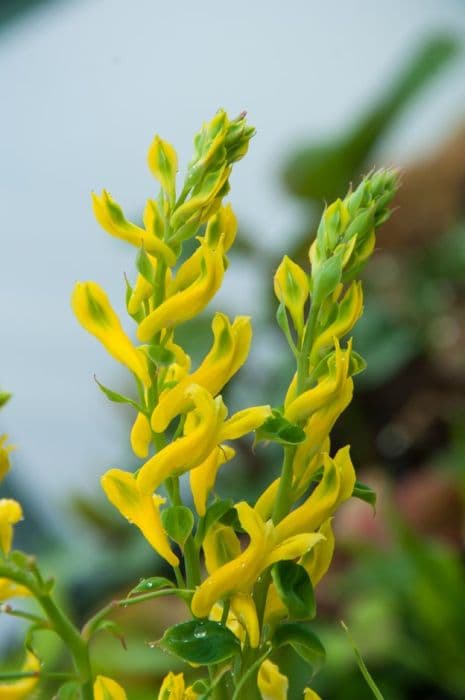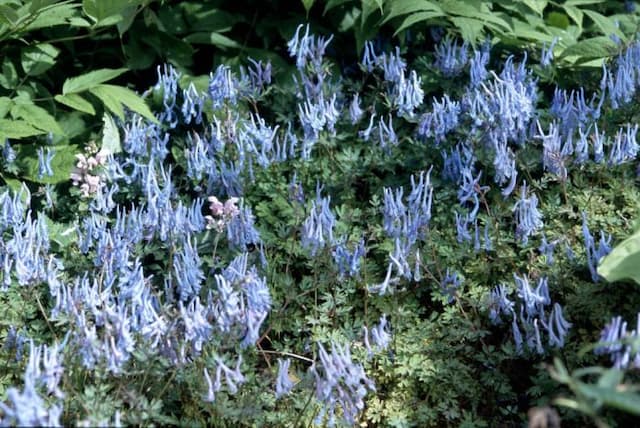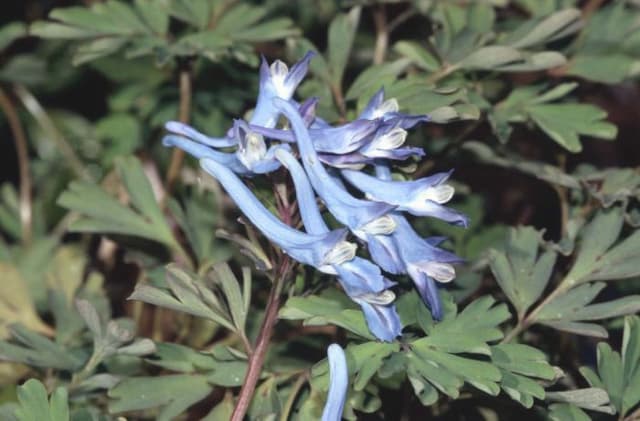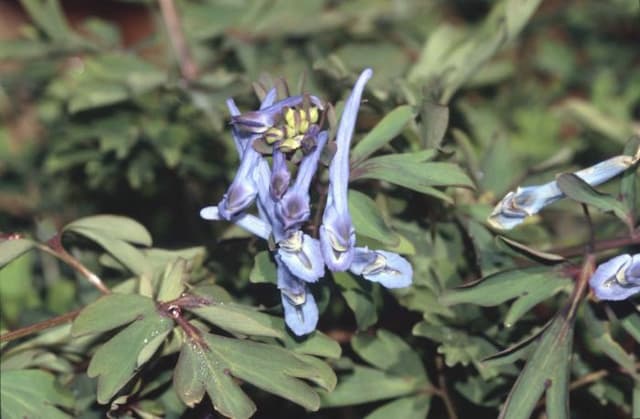Kingfisher Corydalis Corydalis 'Kingfisher'

ABOUT
Corydalis 'Kingfisher' is a delicate and ornamental plant that features a striking combination of finely dissected, fern-like blue-green foliage. The leaves are often described as lacy and are a feature in themselves, even when the plant is not in bloom. The bloom period brings forth a profusion of tubular flowers that typically exhibit a gorgeous shade of blue, creating an eye-catching contrast with the foliage. The blossoms are arranged in racemes, which means they form a cluster along the tip of the stems, with each individual bloom resembling a small trumpet or slipper in shape, adding to the plant's overall fairy-tale charm. The Corydalis 'Kingfisher' is known for its bright and vibrant flowers, which can add a pop of color to any garden space. The delicate look of the plant is enhanced by the way the blooms and foliage sway gracefully with the slightest breeze, creating a dynamic and captivating display.
About this plant
 Names
NamesFamily
Papaveraceae
Synonyms
Fumewort, Blue Corydalis
Common names
Corydalis 'Kingfisher'.
 Toxicity
ToxicityTo humans
The plant known as Corydalis is not widely regarded as highly toxic to humans. However, it does contain alkaloids that can have pharmacological effects. If large quantities were ingested, it might cause mild gastrointestinal discomfort or central nervous system effects such as dizziness or fatigue. Due to the presence of various alkaloids, caution is advised, and it is recommended to avoid consuming this plant.
To pets
Corydalis is similarly not well-known for being highly toxic to pets. Just like in humans, it contains alkaloids, which can potentially cause mild gastrointestinal upset or central nervous system effects in animals if ingested in significant amounts. Symptoms could include vomiting, diarrhea, or lethargy. It is best to prevent pets from ingesting this plant.
 Characteristics
CharacteristicsLife cycle
Perennials
Foliage type
Deciduous
Color of leaves
Green
Flower color
Blue
Height
1 foot 2 inches (35-40 cm)
Spread
1 foot (30 cm)
Plant type
Herb
Hardiness zones
5
Native area
Asia
Benefits
 General Benefits
General Benefits- Aesthetic Beauty: Adds vibrant colors and unique texture to gardens with its delicate blue flowers and feathery foliage.
- Ease of Care: Relatively low maintenance, requiring minimal care once established in an appropriate environment.
- Attracts Wildlife: Can attract bees, butterflies, and other pollinating insects, enhancing biodiversity in the garden.
- Shade Tolerance: Thrives in part shade, making it ideal for woodland gardens or areas with dappled sunlight.
- Seasonal Interest: Offers early spring blooms that provide color and interest after the winter months.
- Compact Growth: Suitable for small gardens or borders without overwhelming the space due to its compact size.
- Deer Resistance: Often resistant to deer, preventing damage to the plant and maintaining its aesthetic appeal.
- Hardiness: Perennial nature and cold hardiness make it a resilient choice for many temperate climates.
- Versatility: Can be used in rock gardens, borders, and containers, offering various landscaping options.
- Non-Invasive: Unlike some ornamental plants, it typically does not aggressively spread and is considered non-invasive.
 Medical Properties
Medical Properties- This plant is not used for medical purposes.
 Air-purifying Qualities
Air-purifying QualitiesThis plant is not specifically known for air purifying qualities.
 Other Uses
Other Uses- Corydalis 'Kingfisher' can be used in potpourri mixtures for its delicate fragrance and attractive foliage, adding a touch of nature's scent to your home.
- The plant's colorful blooms can be used to create natural dyes for textiles, offering hues that range from soft yellows to vibrant blues.
- The flowers of Corydalis 'Kingfisher' can be pressed and included in botanical art projects or in personalized stationery for a touch of elegance.
- Plant enthusiasts may cultivate Corydalis 'Kingfisher' for ornamental use in terrariums, where their compact growth habit can be showcased.
- Its attractive flowers can be used in a flower arrangement or a bouquet to add a splash of color and a wildflower look.
- Gardeners might use Corydalis 'Kingfisher' as a natural pest deterrent; its scent may help keep certain insects at bay.
- With its interesting foliage, the plant can be used as a backdrop in macro photography to enhance the subject and add depth to the photo.
- The seed pods can be used in dried flower arrangements, providing an interesting texture and visual appeal long after the blooming season.
- Corydalis 'Kingfisher' can be used as an educational tool for botany students to study the lifecycle of perennial plants.
- Its presence in a garden may support local wildlife, such as providing nectar for pollinators like bees and butterflies.
Interesting Facts
 Feng Shui
Feng ShuiThe Corydalis is not used in Feng Shui practice.
 Zodiac Sign Compitability
Zodiac Sign CompitabilityThe Corydalis is not used in astrology practice.
 Plant Symbolism
Plant Symbolism- Hope: Corydalis, in general, is often associated with hope due to its ability to thrive in tough conditions and bring color to shady garden areas.
- Tranquility: The 'Kingfisher' variety, with its vibrant yet calming blue flowers, may represent peace and serenity.
- Overcoming Challenges: Since Corydalis can grow in difficult environments, it may symbolize resilience and the ability to overcome difficulties.
- Joy: The bright blossoms of the Corydalis 'Kingfisher' are said to symbolize joy and happiness, reflecting its cheerful appearance.
 Water
WaterCorydalis should be watered regularly to maintain evenly moist soil, particularly during the spring and summer growing seasons when the plant is most active. It's best to water this plant every few days, adjusting frequency based on weather conditions and the plant's life cycle, usually equating to about one inch of water per week. During periods of high heat or drought, you may need to water more often to prevent the soil from drying out. Always provide water directly to the base of the plant, avoiding overhead watering that can promote fungal diseases. Over-watering should be avoided as well, particularly in winter when the plant requires less moisture and too much water can lead to root rot.
 Light
LightCorydalis 'Kingfisher' prefers a spot in partial shade with protection from the intense afternoon sun. It flourishes in an environment that offers morning sunlight and dappled afternoon shade, which mimics the light conditions of its natural woodland habitat. Ensure the plant is positioned in a location where natural light is filtered by nearby plants or shading structures, but it still receives enough light to support healthy growth.
 Temperature
TemperatureCorydalis thrives in temperate climates and does well in temperatures ranging from 50 to 75 degrees Fahrenheit. However, it can survive minimum temperatures down to about 20 degrees Fahrenheit as long as the ground does not freeze. To encourage optimal growth, try to maintain the temperature around the ideal range, and protect the plant from extreme heat or cold by providing mulch or shade coverings as necessary.
 Pruning
PruningPruning Corydalis 'Kingfisher' involves deadheading spent blooms to promote further flowering and removing any dead or damaged foliage to maintain plant health. Pruning is best done after flowering to shape the plant and encourage new growth. Regular pruning is not necessary; however, light trimming can be done as needed throughout the growing season.
 Cleaning
CleaningAs needed
 Soil
SoilFumewort (Corydalis 'Kingfisher') thrives in loose, well-draining soil with a high organic matter content; a mixture of loam, peat, and sand is ideal. The pH should be slightly acidic to neutral, ranging from 6.0 to 7.0 for optimal growth.
 Repotting
RepottingFumewort should be repotted every 1-2 years to refresh the soil and accommodate root growth. Spring is the best time to repot this plant, ensuring minimal stress and quicker recovery.
 Humidity & Misting
Humidity & MistingFumewort prefers moderate to high humidity environments. Maintaining a humidity level of around 50% to 70% will help this plant flourish indoors.
 Suitable locations
Suitable locationsIndoor
Place Fumewort in bright, indirect light and keep soil moist.
Outdoor
Plant Fumewort in dappled shade and moist, well-drained soil.
Hardiness zone
5-7 USDA
 Life cycle
Life cycleCorydalis 'Kingfisher', commonly known as Fumewort, begins its life cycle when seeds are dispersed by wind or rain and germinate either in autumn or spring, depending on environmental conditions. After germination, seedlings develop a rosette of leaves and a root system. As the plant matures, it forms a clump of divided, fern-like leaves and stems that may reach up to 40cm tall. In early spring, Fumewort produces delicate, tubular blue flowers that provide nectar for early-season pollinators. Following pollination by insects, the flowers develop into elongated seed pods that split open when ripe to release the seeds, continuing the cycle. During the summer, the plant goes dormant, with above-ground parts dying back, and it survives the hotter months as a tuber underground until the next favorable growth season.
 Propogation
PropogationPropogation time
Spring to Summer
The Corydalis 'Kingfisher', also known as Corydalis flexuosa 'Kingfisher', is usually propagated by dividing the tubers. The best time for this method is in the fall after the plant has finished flowering and the foliage has started to die back. To propagate by division, carefully dig up a mature clump of Corydalis 'Kingfisher' and gently separate the tubers, ensuring that each division has at least one growth point or eye. Replant the divisions immediately at the same depth they were growing at before, spacing them about 10 to 12 inches (approximately 25 to 30 centimeters) apart to give each new plant enough room to grow. Water the newly planted divisions thoroughly to help establish them. This method encourages healthy, vigorous growth and will help proliferate your Corydalis 'Kingfisher' garden with identical plants to the parent.









